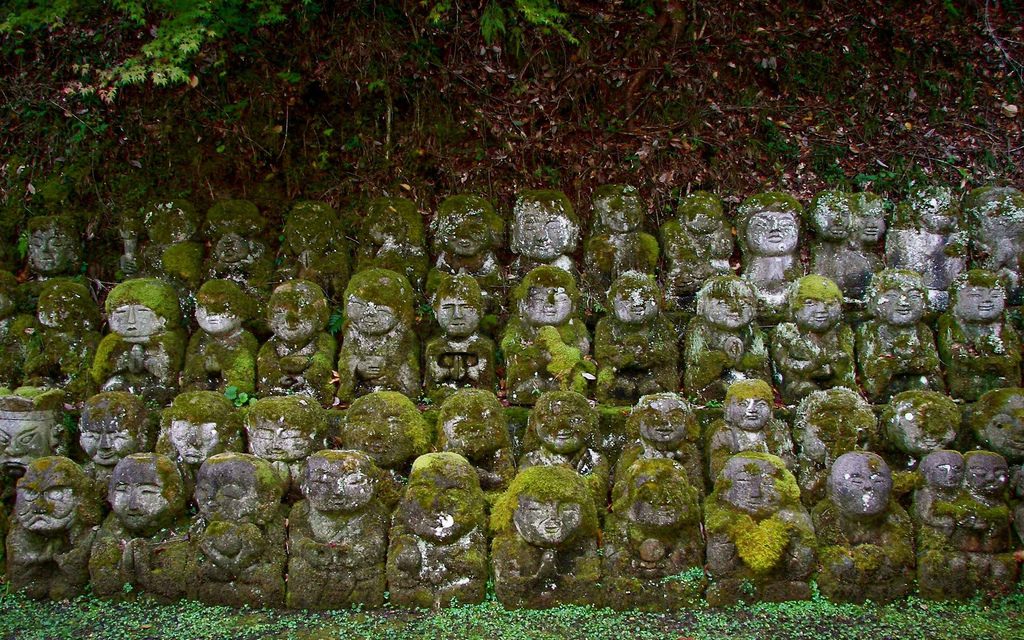Arashiyama is one of Kyoto’s most beautiful neighbourhoods, and hundreds of thousands of tourists visit there every year, but unfortunately, almost no one ever makes it to the area’s most interesting temple. It’s called Otagi Nenbutsu-ji, and it has some of the funniest, most fascinating and beautiful Buddhist sculptures in the entire country.
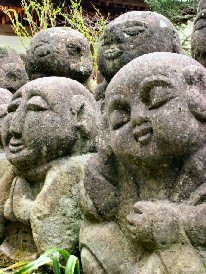 Originally founded by Emperor Shotoku in the middle of the eighth century, this temple has had some seriously bad luck. It was first built in the Higashidera area of Kyoto, but was destroyed by a flood of the Kamo River, and was rebuilt as a branch of Enryaku-ji, the famous Tendai sect temple on Mt. Hiei. Its main hall was burned to the during a civil war in the thirteenth century, and after moving to its present location in 1922, it suffered severe damage in a typhoon.
Originally founded by Emperor Shotoku in the middle of the eighth century, this temple has had some seriously bad luck. It was first built in the Higashidera area of Kyoto, but was destroyed by a flood of the Kamo River, and was rebuilt as a branch of Enryaku-ji, the famous Tendai sect temple on Mt. Hiei. Its main hall was burned to the during a civil war in the thirteenth century, and after moving to its present location in 1922, it suffered severe damage in a typhoon.
From the road, Otagi Nenbustu-ji looks like a very ordinary temple, but after passing through the gate, with its two typically terrifying Nio statues (the fierce looking guardians one often finds at the entrance to temples), you will notice two more Nio, and these definitely tend toward the cute, rather than the ferocious end of the spectrum.
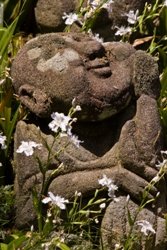 These kawaii guardians are just the beginning though, and there are more than 1200 statues on the temple’s grounds. Walking up the path to the main hall, there are dozen or so strange little faces peering down at you, most of them half-hidden in the tall grass. Although they will give you some hint of the strangeness you are about to encounter, most visitors are still shocked when they see the hundreds of bizarre figures carved in grey stone by the main hall of the temple.
These kawaii guardians are just the beginning though, and there are more than 1200 statues on the temple’s grounds. Walking up the path to the main hall, there are dozen or so strange little faces peering down at you, most of them half-hidden in the tall grass. Although they will give you some hint of the strangeness you are about to encounter, most visitors are still shocked when they see the hundreds of bizarre figures carved in grey stone by the main hall of the temple.
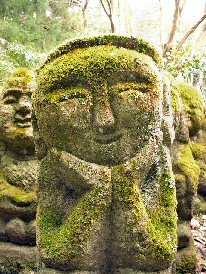 These statues are called rakan, and they represent the 500 disciples of Buddha. Although many Buddhist sculptures are carved to represent exquisite beauty or terrifying ferociousness, rakan almost always seem to be carved in the spirit of humour and good fun. There are also Rakan-ji temples in Otaru (Hokkaido) and Oita (Kyushu) with carvings every bit as bizarre as those at Otagi Nenbutsu-ji, but the statues here are special because most of them were made by amateur carvers.
These statues are called rakan, and they represent the 500 disciples of Buddha. Although many Buddhist sculptures are carved to represent exquisite beauty or terrifying ferociousness, rakan almost always seem to be carved in the spirit of humour and good fun. There are also Rakan-ji temples in Otaru (Hokkaido) and Oita (Kyushu) with carvings every bit as bizarre as those at Otagi Nenbutsu-ji, but the statues here are special because most of them were made by amateur carvers.
In 1981, when the 1950 typhoon damage was finally repaired, worshippers at the temple decided to donate rakan sculptures to the temple in honour of its refurbishing. A famous sculptor, Kocho Nishimura taught hundreds of sculptors, amateur and professional alike how to carve statues from stone, and the result is a delightful mix of serene and scary, somber and silly.
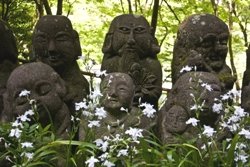 Spend a few hours there and see if you can find the surfing Buddha, the two tipplers, the saxophone player, the photographer and the disciple doing a handstand. Since the installation of the Rakan, a custom has evolved among visitors to the temple of trying to find a statue that resembles your own face. It can be fun, but you may be in for a shock if you go with someone else and are suddenly told that the buck-toothed, bowl cut-sporting statue with a nose the size of a potato looks a lot like you.
Spend a few hours there and see if you can find the surfing Buddha, the two tipplers, the saxophone player, the photographer and the disciple doing a handstand. Since the installation of the Rakan, a custom has evolved among visitors to the temple of trying to find a statue that resembles your own face. It can be fun, but you may be in for a shock if you go with someone else and are suddenly told that the buck-toothed, bowl cut-sporting statue with a nose the size of a potato looks a lot like you.
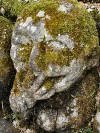 The temple must be one of the mossiest, most eroded places in Kansai, and walking its grounds, one has the distinct impression that man is fighting a losing battle with nature here. All in all it’s a very mysterious place, always a little dark and always the moss on the statues and the way they are being eroded just adds to the atmosphere.
The temple must be one of the mossiest, most eroded places in Kansai, and walking its grounds, one has the distinct impression that man is fighting a losing battle with nature here. All in all it’s a very mysterious place, always a little dark and always the moss on the statues and the way they are being eroded just adds to the atmosphere.
Getting there: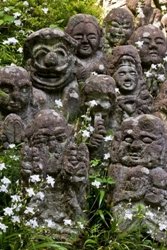
From Kyoto station, take bus 72 to Otagidera Mae (おたぎでら前). From Hankyu Arashiyama station, take bus 62 or 72 to Otagidera Mae. If you know Arashiyama, go to Adashino Nenbutsu-ji and follow the walking path north. You’ll come to Otagi in about 10 minutes.
Cover photo credit: jimoneilalaska

